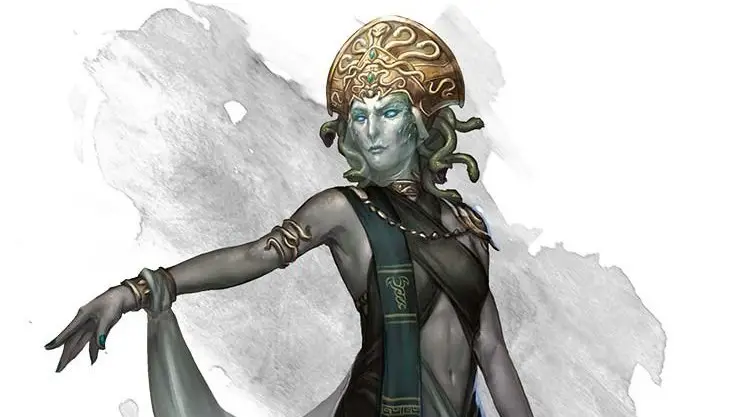With so many terrifying and ferocious monsters in Dungeons & Dragons, I’ve always had a special soft spot for those based on real-world myths and legends.
One of the greatest examples of this is the Medusa.
With a head of snakes instead of hair and a gaze that will turn those who look at them into stone, these are not being to take lightly. An adventurer may be exploring the ruins of an ancient temple only to find themselves added to the décor before they know what hit them!
So beware, dear adventurer, and read this guide to the Medusa in D&D 5e before you explore that next dungeon!
Medusa Lore
While most people commonly think of Medusas as being female, they can actually be any gender.
These creatures are individuals who sought beauty and eternal life enough that they made deals with powerful, dark entities to achieve these wishes. But beauty fades and eternal life can quickly become a curse…
There’s always a catch when you make deals with archdevils, demon lords, or dark deities capable of granting such a wish!
Where this individual was able to live a life of beauty and be the subject of admiration from everyone around them, many years later they find themselves transformed into a Medusa. Their hair is a nest of venomous snakes and all who look into their eyes are turned to stone.
More often than not, Medusas will retreat from the society that once worshipped them. They make their homes in abandoned temples or once-beautiful ruins where they can live in quiet seclusion.
Medusas are quick to destroy any kind of reflective surfaces or mirrors in their lair. Just as their gaze can turn others to stone, it can just as quickly do the same to themselves.
When adventurers come to the temple in search of treasure, the Medusa sticks to the shadows. It may not be the strongest of combatants, but the element of surprise and a single glance are all it needs to take care of the intruders for good.
Related: 10 D&D Monsters From Real-World Mythology
Medusa Abilities in D&D 5e
Medusas are capable of using weapons like a longbow or shortsword, but they have two primary abilities that they can rely on.
The Medusa’s snake hair isn’t just for looks! A bite from one of these snakes deals only 1d4+2 piercing damage, but don’t get comfortable! It also deals 4d6 poison damage! That’s an average of 18 damage from just the snakes!
If the Medusa is close enough to be attacking you with its snakes, it will be taking full advantage of all three of its attacks: one with the snakes and two strikes with its shortsword.
But there’s another thing to worry about if you find yourself this close to a Medusa: their gaze.
At the start of a creature’s turn, if they are within 30 feet of a Medusa and can see its eyes, they have to make a DC 14 Constitution saving throw. (Unless the Medusa is incapacitated or can’t see them!)
A DC 14 isn’t terrible, but the consequences are pretty severe. If a creature fails by 5 or more, they are instantly petrified.
If the creature fails by less than 5, the petrification isn’t instant. They are restrained but can repeat the saving throw at the end of their next turn. If they succeed, they are freed for now. If they fail this one, they are petrified. (Use your Inspiration if you’ve got it in this kind of situation!)
Once a creature is petrified, it will take casting greater restoration or some other powerful magic to save them.
Just keep in mind that the Medusa and the creature being targeted by their gaze have to be able to see each other.

Medusas in Combat in D&D 5e
Medusas are fairly hardy, but they aren’t particularly well-suited to taking an adventuring party on directly.
Because Medusas are so solitary, it’s unlikely that it will have allies in the encounter. Unless the Medusa is able to quickly petrify at least a couple of the party members, it will be very quickly dogpiled.
It might be able to make a couple of ranged attacks with its longbow from a hiding place, but doing so could blow the element of surprise.
Medusa Lairs
If you’re a DM looking to use a Medusa in your own game, consider really building out the Medusa’s lair. They’re smart enough to know how to lay traps and wise enough to be able to pick and choose when they will strike.
Ultimately, the terrain will be the Medusa’s greatest ally as they look for opportunities to ambush the party and pick off stragglers.
When considering what kind of monsters might lurk in the Medusa’s lair, look for those that would be immune to its Petrifying Gaze like slimes or Stone Golems. Giant spiders or swarms of rats might have made their home in the Medusa’s lair and know to keep their distance.
If you really want to add some extra challenge, you might consider having the Medusa be able to animate some of the statues that adorn their lair. You could use the Stone Cursed from Morkenkainen’s Tome of Foes or weakened Stone Golems (medium instead of large) for this.
As Medusas appear in the Monster Manual, they don’t legendary or lair actions. If you want to add a great deal of tension to the encounter, these make for considerable buffs.
As the party goes deeper into the Medusa’s lair, you’ll want to build the tension.
You might have an NPC go with the party. This character might find themselves separated from the party. When the party hears the NPC scream, they rush to investigate and find their companion turned to stone with a look of horror on their face.
There should be a feeling of being hunted. The Medusa could be around any corner…
But then again… so could the treasure…
Related: The Ultimate Playbook For Monster Tactics in D&D 5e

The Element of Surprise
When the Medusa gets its opportunity to strike, it wants to act as quickly and decisively as possible.
Emerging from its hiding place, it immediately forces whatever creature it’s ambushing to make a save with its Petrifying Gaze.
If they aren’t instantly petrified, they are still restrained. This means that the Medusa can unload three attacks (one with its snakes and two with its sword) with advantage.
As the target’s allies turn to react, they’ll also have to make Constitution saves to resist being petrified.
If the Medusa stays to fight, the party will have to make this save each turn or fight blind. This makes for a huge challenge as the fight goes on.
If the Medusa prefers to hit-and-run, they’ll need to get craftier with their ambushes as the party will now be on edge. Because the party members are likely closing/covering their eyes, it might be able to make a quick getaway if things are going south. This way the Medusa can ambush again when the odds are back in their favor.
The ideal situation for the Medusa is being able to catch multiple creatures in its gaze at once. It might ambush to specifically attack whichever party member it thinks it can drop the quickest, but it will want the other party members to be able to see it and within 30 feet.
Conclusion – Medusa in D&D 5e
Not only is the Medusa a fantastic D&D monster, but there’s also such a tragic element to their lore that can be incorporated into the encounter.
Hideous and completely alone, the Medusa broods in their lair missing the days where they were beautiful and admired. On one hand, they want nothing more than to be released from their curse. On the other hand, their fear of death is exactly what drove them to make their dark bargain in the first place.
An encounter with a Medusa is both terrifying and somber at the same time.
What monster would you like to see featured next? Let me know in the comments below and don’t forget to sign up for the Tabletop Joab newsletter so you never miss a thing!









